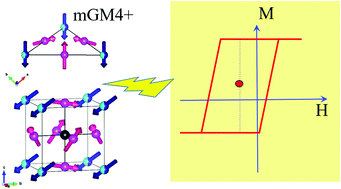Giant spontaneous exchange bias in an antiperovskite structure driven by a canted triangular magnetic structure†
Abstract
Exchange bias (EB) effect, generally observed in systems consisting of ferromagnetic and antiferromagnetic layers after a cooling procedure in a high magnetic field, is highly desirable for technological applications ranging from spintronics to magnetic recording. Achieving a giant EB effect near room temperature in a small cooling field is thus an on-going technologically relevant challenge for the materials science community. In this work, we present the experimental realization of such a fundamental goal by demonstrating the existence of giant EB after a zero field cooled (ZFC) procedure in antiperovskite Mn3.5Co0.5N below 256 K. We found that it exhibits an EB field of −0.28 T at 50 K after a ZFC procedure accompanied by a large vertical magnetization shift (VMS). Interestingly, this EB field can be elevated up to −1.2 T after a cooling procedure with a small applied field of just 500 Oe. Mn3.5Co0.5N represents the first intermetallic material showing a strong correlation between EB and VMS. We attribute the observed EB effect to a new canted triangular magnetic structure in antiperovskites determined by a neutron diffraction experiment. Finally, we discuss the striking effect of Co substitution on the physical properties of antiperovskite materials and put forward a new strategy for the antiperovskite lattice to exploit new single phase materials showing large EB effect at room temperature.



 Please wait while we load your content...
Please wait while we load your content...